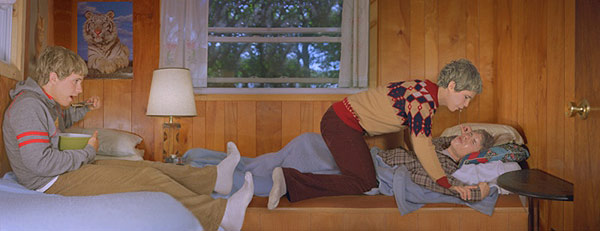Anthony Goicolea

About the Exhibition
Anthony Goicolea (United States, born 1971) creates fantastic photographic tableaux that provocatively explore the eccentricities of adolescence. Using makeup, wigs, and costumes, Goicolea-now thirty years old-transforms himself into the cute, pubescent protagonist of his pictures, essentially performing the metamorphosis of adolescence in reverse. He then utilizes digital technology to place his character multiple times in each photograph, creating a world in which identical boys act out oddball scenarios with their own doubles. By reflecting typical preoccupations of adolescence, including rebellion, sexuality, the transmutation of identity, and the intensity of relationships with peers, Goicolea’s pictures poignantly express the peculiarity of an age when discretion is often at the mercy of hormones.
At once humorous and disturbing, Goicolea’s photographs find their inspiration in a variety of sources, including fairytales, art history, and personal experience. Although many of the images appear timeless, some are firmly lodged in 1970s suburban America; the moment and place of Goicolea’s own childhood. Growing up in a Cuban-American household in Marietta, Georgia, presented Goicolea with the stories and folklore of two different cultures. He remembers melding and convoluting the stories in his mind much as he does in his photographs today. In his Fairytale Series of 1996, Goicolea first united photographic self-portraiture with his affection for fairytales by dressing up like various storybook characters. In his most recent series, Multiple Portraits (1999-2001), he pastiched various elements from myths, rhymes, and fables into narrative slices that hint at taller tales. Goicolea cites as a particular influence on his work the fairytales collected by the German Brothers Grimm, renowned for their unvarnished depiction of many of the cruelties of life, including death, betrayal, and famine. Like the Grimms’ stories, Goicolea’s photographs effectively taint the fanciful with dark undercurrents of reality.
Goicolea studied art history, drawing, and painting as an undergraduate at the University of Georgia and earned an M.F.A. in sculpture and photography from Pratt Institute in New York in 1996. Goicolea brings all of these skills to the construction of his photographs, which is an additive, almost sculptural, process. In a process akin to a theatrical production, Goicolea plays all of the parts: set builder, wardrobe designer, make-up artist, stylist, director, star, as well as photographer and digital technician. This manifold approach is extremely time consuming; the preparation of the mise-en-scène, the costuming, and the photography for a single image usually take a week, and the digital composition of the final photograph takes at least one month.
Although originally Goicolea used himself as a model for reasons of convenience, his digital self-replication quickly proved a whimsical exploration into the concept of vanity. He explains: “Someone once asked me, ‘If you saw yourself sitting alone in a bar, would you ask yourself out?’ It’s that sort of questioning of self-love and self-hate that I want to explore.”1 In Boys’ Room (2000), Goicolea posed this question pictorially, as one Goicolea-boy dressed for a dance pins a white rose onto another’s lapel. Meanwhile, a third boy reenacts the myth of Narcissus as he kisses his own reflection in the bathroom mirror. In Goicolea’s world of clones, when boys love each other, they love themselves, and as they chart their newfound sexuality, they experiment. They wear make-up, touch tongues, urinate, spit, lick, and hold hands, testing the limits of gender identification and displaying an obsession with bodily functions and fluids.
In many of Goicolea’s pictures, bands of boys act defiant and rebellious in the face of regimented structure. Cloaked in ambiguous uniforms that reference rigidly organized social institutions, such as the church or school, the boys engage in perpetual mischief. In Feastlings (2000), for example, boys wearing navy blazers with white piping spit milk, swing sausage links, and ricochet lima beans around a fancy dining hall as a stalwart, anonymous Mr. and Mrs. gaze out from paintings on the wall. In Last Supper (1999), boys compete for and greedily devour morsels of sliced Wonder Bread. Reminiscent of Hansel and Gretel’s ill-fated return from abandonment in the forest, Goicolea’s boys are left to their own devices. Instead of wisely rationing their bread, they squander it in a frenzy of greed and ravenous hunger. Unlike Leonardo’s Last Supper, there is no Christ figure; all of the boys are equal and uniformly costumed in anachronous cloaks that hint at the civilization they might have escaped. Like the stranded boys in William Golding’s novel Lord of the Flies who become increasingly barbaric in the absence of societal restraints, these boys slide into an abyss of savagery, reminding us that during adolescence, survival of the fittest is often the principal game.
Bruno Bettelheim writes in The Uses of Enchantment, “In a fairy tale, internal processes are externalized and become comprehensible as represented by the figures of the story and its events.”2 Goicolea’s photographs function in much the same way, by mining obsessions that usually remain unmentionable and stirring memories of adolescent anxieties that we would perhaps rather forget. Wild, wicked, and colorful, Goicolea’s pictures demonstrate that the obsessions of adolescence are in some ways always with us. A teller of perverse tales, Goicolea uses his imagination as a portal to our own as he cheerfully engages the taboo.
-Karen Irvine, Associate Curator
1. Interview with Shannon Hall, Detour, February 1000, p. 44.
2. Bruno Bettelheim, The Uses of Enchantment (New York: Alfred A. Knopf, Inc., 1975), p. 25
Image Gallery
